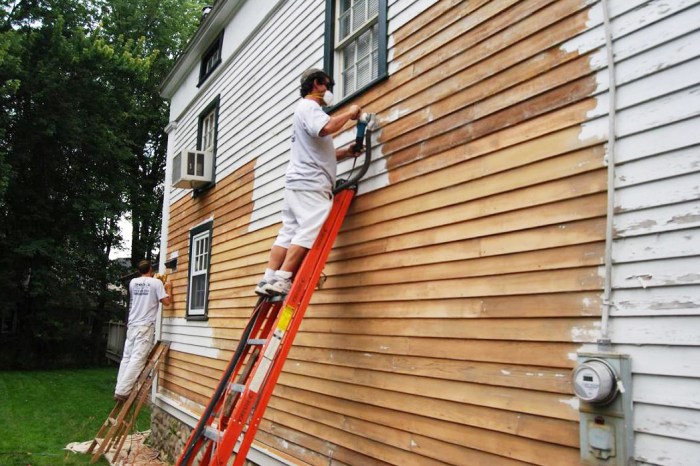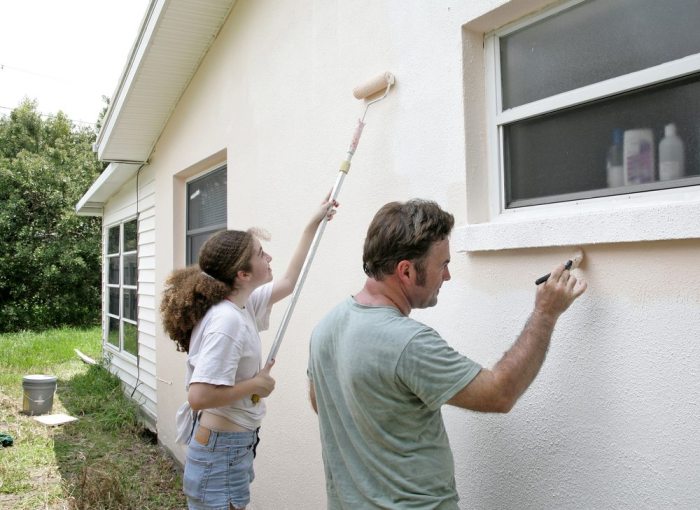Choosing the Right Paint Colors for Painting Outside of House
Embarking on the journey of painting the exterior of your house involves more than just selecting colors. It's about transforming your home's appearance and ensuring it stands out in the neighborhood. From vibrant hues to subtle tones, the choices are endless.
Let's dive into the world of painting outside of house and explore the key aspects to consider.
When it comes to enhancing your home's curb appeal, the color palette you choose plays a crucial role. Let's delve into the nuances of selecting the perfect paint colors for your exterior.
Choosing the Right Paint Colors
When it comes to painting the exterior of your house, selecting the right paint colors is crucial in achieving the desired look and enhancing the overall curb appeal. Here are some tips to help you choose the perfect colors for your home.
Popular Paint Color Choices
- Neutral tones like beige, gray, and white are timeless choices that work well with various architectural styles.
- Earth tones such as brown, green, and terracotta can create a warm and inviting feel.
- Bold colors like navy blue, deep red, or forest green can add a pop of personality and make your house stand out.
Selecting Colors that Complement the Style
- Consider the architectural style of your house when choosing paint colors. For example, a Victorian-style home may look best with classic, muted tones, while a modern house can handle more vibrant colors.
- Look at the existing elements of your home, such as the roof color, landscaping, and any brick or stone accents, to ensure the paint colors complement these features.
Considering the Surroundings
- Take into account the surrounding environment when selecting paint colors. A house nestled in a lush green landscape might benefit from earthy tones, while a beach house could look stunning in shades of blue and white.
- Think about the neighboring houses and the overall aesthetic of the neighborhood to ensure your color choices harmonize with the surroundings.
Preparing the Exterior Surface
When it comes to painting the exterior of your house, proper preparation of the surface is crucial to ensure a long-lasting and professional-looking finish.Cleaning the surface before painting is essential to remove dirt, grime, and other contaminants that can prevent the paint from adhering properly.
This can be done using a pressure washer, scrub brush, or a mixture of water and mild detergent.
Methods for Preparing the Surface
- Sanding: Sanding the surface helps to smooth out any rough areas and create a better surface for the paint to adhere to.
- Priming: Applying a primer before painting can help to seal the surface, improve adhesion, and enhance the durability of the paint job.
- Scraping: Scraping off any loose or peeling paint is important to ensure a smooth and even finish.
Repairing Damaged Areas
- Fill in any cracks or holes with a suitable filler to ensure a uniform surface for painting.
- Replace any rotting or damaged wood to prevent further deterioration and ensure a solid foundation for the new paint.
- Address any water damage or mold issues before painting to avoid future problems.
Selecting the Right Painting Tools
When painting the exterior of a house, having the right tools is crucial to achieving a professional finish. Here are some essential painting tools you will need:
Paint Brushes
- Nylon/polyester brushes: Versatile and suitable for most paint types.
- Natural bristle brushes: Ideal for oil-based paints.
- Cutting-in brush: Helps with precision painting in corners and edges.
Rollers
- Low nap roller: Best for smooth surfaces like siding and trim.
- Medium nap roller: Ideal for textured surfaces like stucco or brick.
- High nap roller: Great for rough surfaces like concrete or masonry.
Paint Sprayer
Using a paint sprayer can be advantageous for painting larger areas quickly and efficiently. Some benefits of using a paint sprayer include:
- Even coverage: Sprayers can provide a more uniform coat of paint compared to brushes or rollers.
- Time-saving: Sprayers can cover large surfaces in a fraction of the time it would take with traditional methods.
- Accessibility: Sprayers can reach areas that may be difficult to paint with brushes or rollers, such as high walls or ceilings.
Techniques for Painting the Exterior

When painting the exterior of a house, it's important to follow proper techniques to ensure a professional finish that will last. Here are some key tips to keep in mind:
Applying Primer
- Before painting the exterior, it's crucial to apply a coat of primer to help the paint adhere better to the surface.
- Use a high-quality exterior primer that is suitable for the surface material, whether it's wood, stucco, or concrete.
- Apply the primer evenly using a paintbrush or roller, making sure to cover all areas that will be painted.
- Allow the primer to dry completely before applying the paint to achieve the best results.
Painting Large Areas Efficiently
- When painting large exterior areas, such as walls or siding, it's best to use a paint sprayer for faster and more efficient coverage.
- Start by painting in small sections, overlapping each stroke slightly to ensure even coverage.
- Work from the top down to avoid drips and streaks, and paint in the direction of the wood grain or siding for a seamless finish.
- Take breaks as needed to avoid fatigue and maintain a steady hand for a professional-looking result.
Achieving a Smooth Finish
- To achieve a smooth and even finish on the exterior, apply the paint in thin, even coats, allowing each layer to dry before applying the next.
- Use high-quality exterior paint and a good quality brush or roller to ensure even application and coverage.
- Check for drips or runs as you work and smooth them out immediately to prevent uneven surfaces.
- Consider using a paint conditioner or extender to help the paint flow smoothly and reduce brush marks for a flawless finish.
Dealing with Weather Conditions
When painting the exterior of a house, it is crucial to consider the weather conditions to ensure a successful paint job that lasts. Here are some tips to help you navigate through different weather scenarios:
Choosing the Right Time of Year
It is ideal to paint the exterior of your house during moderate weather conditions. Avoid extreme temperatures, such as intense heat or cold, as they can affect the paint's drying process and adhesion to the surface. The best time to paint is during the spring or fall when temperatures are mild and humidity levels are moderate.
Impact of Different Weather Conditions
- High Temperatures: Extreme heat can cause the paint to dry too quickly, leading to cracking and blistering. It is advisable to paint early in the morning or late in the afternoon to avoid direct sunlight.
- Rain: Moisture from rain can ruin a fresh paint job, causing streaks, bubbles, or wash-off. Make sure to check the weather forecast before starting the painting process and avoid painting if rain is expected within 24 hours.
- Humidity: High humidity levels can prolong the drying time of paint, leading to sagging or wrinkling. Consider using a dehumidifier in damp areas to speed up the drying process.
- Wind: Strong winds can blow debris onto wet paint, causing imperfections. Choose a calm day to paint and protect the surrounding area from dust and dirt.
Tips for Protecting the Paint Job
- Use high-quality exterior paint that is designed to withstand different weather conditions.
- Apply multiple thin coats of paint rather than one thick coat to ensure proper adhesion and durability.
- Allow enough drying time between coats and avoid painting during rainy or humid days.
- Consider investing in a good quality primer to protect the surface and improve paint adhesion.
- Inspect the painted surface regularly and touch up any areas that show signs of wear or damage.
Final Wrap-Up

As we conclude our discussion on painting outside of house, one thing is clear - a fresh coat of paint can breathe new life into your property. By carefully considering color schemes, surface preparation, tools, techniques, and weather conditions, you can achieve a stunning transformation.
Make your house the envy of the neighborhood with a well-executed exterior paint job.
Quick FAQs
Question: What are some popular paint color choices for the exterior of a house?
Answer: Popular choices include neutral tones like beige, gray, or white for a classic look, or bold colors like navy blue or forest green for a more dramatic statement.
Question: Why is cleaning the surface before painting important?
Answer: Cleaning ensures better adhesion of the paint and helps remove dirt, grime, and old paint, resulting in a smoother finish and longer-lasting paint job.
Question: What are the essential painting tools needed for painting the exterior of a house?
Answer: Essential tools include paint brushes, rollers, a ladder, masking tape, paint trays, and a paint sprayer for larger areas.
Question: What is the best time of year for painting outside of a house?
Answer: Ideally, choose a time with moderate temperatures and low humidity to ensure proper drying and adhesion of the paint. Spring and fall are generally good seasons for exterior painting.




